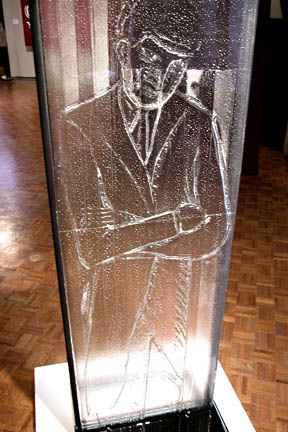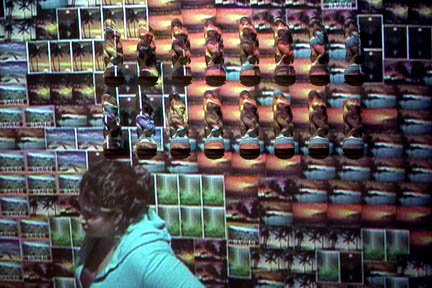
One of five images from Jacob Jackson's untitled ceramics series that examines the distortion of the Hawaiian culture.
World views
UH graduate art students use
a variety of materials to comment
on daily life
WHAT does it take to make a great leader? The most common virtues, many people would agree, are vision and insight, an ability to move others, to capture attention and imagination, to be inspiring. Where would one find such folk in the making? A law school? Maybe a student government group? Well, how about an art studio?
"Instance"Works by graduate students of the University of Hawaii-Manoa Department of Art and Art HistoryWhere: University of Hawaii Art Gallery, in the Art Building Hours: Noon to 4 p.m. today, 10:30 a.m. to 4 p.m. Monday through Friday Admission: Free Call: 956-6888
|
JACOB JACKSON calls "Instance" a collection of works "that represent our best efforts, what we'd like to say about the world around us." Jackson's contribution utilizes photo transfer techniques on a series of five ceramic pieces that bear images of tiki and palm trees. His untitled series explores the question, What is Hawaiian culture today?
"I live across the Polynesian Cultural Center, and I see tourists posing with these huge tiki made of Styrofoam," Jackson says. "These figures used to represent gods at one point, and now they're just tacky."
A ceramics major, Jackson works in other materials as well, but he decided ceramics best serves the statement he's trying to make.
"When you look at clay, you can sense the history about it because it is an old art form," he says. "This (work) deals with history, so I thought it was appropriate."
The tiki and trees on the ceramics are in some instances barely decipherable, which Jackson says is his attempt to turn the images into abstractions. "It's (addressing) the evolution of the meaning of palm trees and tiki -- the most typical iconic images of Hawaii -- through time," he says.
"I'm looking at the ground between the sacred and the profane."

Alan P. Ness uses glass, oil and steel "to comment on where our country's headed right now" in "Ask Not What Your Country Can Do For You, But What Your Country is Doing to Others." Ness is among the 28 University of Hawaii graduate art students represented in "Instance," which runs at the UH Art Gallery through Friday.
"I wondered what Kennedy would think" about what's happening with our country today, Ness says.
The artist conveys the fragility of our economy, and our country, through "the fragile medium of glass."
The oil, a multifaceted reference to the war in Iraq and its connection to our economy, possesses reflective qualities, representing "how translucent our economy is these days," Ness says. "You can see the whole piece reflected when you peer into the oil. It's a reflection of our own morals and ideals as a nation."

Karen Goins's work, an oil on canvas, is among a series of four paintings in the show.
The paradise construct "examines what we are being fed (culturally)," she says. "It has been the subject of my work for a long time."
For "Chocolate Dove," Kukahiko covers a wall with touristy postcards of sunsets. On a nearby table, she displays a hula girl cast in chocolate. Next to the figure is a candy tray offering visitors chopped-up pieces of chocolate hula girl, some with macadamia nuts, others with slices of dried mango. Some chunks are recognizable body parts of the hula girl; others are too difficult to make out.
Kukahiko says the mango is a reference to Gauguin, who "served up native feminine sexuality in his work."

Puni Kukahiko's "The Paradise Seekers," is an installation made of chocolate and light. Kukahiko runs live video over 16 white chocolate hula girls.
"When people are selecting the candy, they stay on the video longer," Kukahiko laughs. "I'm still casting chocolate every night."
Kukahiko made the mold of the hula girls herself. "I bought a hula girl statue in Waikiki. The label says she was 'cast in simulated lava,' which means plastic," she says with a grin. "I made a mold out of rubber from it."
Kukahiko says the ideas for her installation came after she couldn't get a hapa-haole Hawaiian song out of her mind. "The title was something like 'I Fell in Love with a Hapa-Haole Hula Girl,'" she says. One of her responses to the song was to address "hybridization" through the use of both dark and light chocolates to cast the hula girls.
While Kukahiko is getting plenty of mileage out of the hula girl mold, one wonders what she would possibly do with all those postcards.
"Maybe I'll mail them out to some unsuspecting friend in some underhanded way," she says, laughing. "I'll accost them with it."

"Slipping up," above, is among eli baxter's humorous mixed media work.
[News] [Business] [Features] [Sports] [Editorial] [Do It Electric!]
[Classified Ads] [Search] [Subscribe] [Info] [Letter to Editor]
[Feedback]
